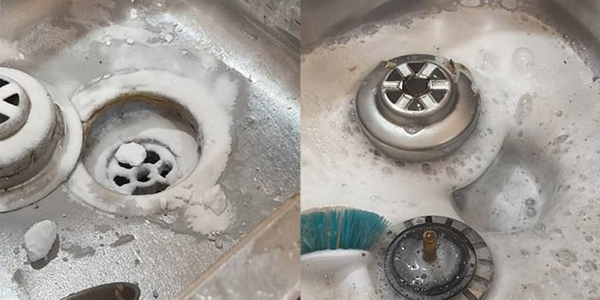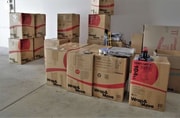The secret to a cleaner kitchen: How to tackle hidden sink grime
Here at the Seniors Discount Club, we love some good cleaning advice to make life just that little bit easier. After all, who wants to spend their golden years scrubbing away endlessly? That's why we were both intrigued and a little horrified by a recent discovery from a Perth mum named Fiona, who goes by That Perth Mum online.
Much to the shock of the internet, Fiona revealed the surprising build-up of grime and dirt hidden in a little-known nook beneath the kitchen sink plug. Her discovery prompted thousands to check their own sinks in fear of what might be lurking underneath.
In a tell-all clip, Fiona demonstrated how sink strainers can be used to unscrew the plug and access the grime underneath. Fiona then tackled the hidden gunk with a combination of bi-carb soda, kitchen spray, and plain white vinegar, making her sink sparkle and shine like new again.

This revelation has us feeling equal parts amazed and grossed out, but this tip could be a game-changer in maintaining a cleaner, more hygienic kitchen. For our more members who appreciate a visual guide, you can watch Fiona's original video for instructions and encouragement.
Here's a step-by-step process:
Many viewers were quick to add this kitchen deep-clean to their to-do list, but some raised concerns about potential damage.
Before you roll up your sleeves, however, we must issue a word of caution to consider your sink's unique specifications. Plumbers were quick to warn our readers that removing the plug might harm the seal around the drain.
Fortunately, plumbers have offered advice on how to protect your kitchen's drainage and plumbing systems while cleaning. They suggest that regular maintenance is key, as small issues can become serious and costly problems if they're not spotted early on.
It's best to start by visualising the layout of your pipes and fittings to help you understand any potential issues. This way, you can treat your kitchen pipes with more understanding and prevent any future clogs or damaged seals.
It's also important to check the strainers and plugs on a regular basis and to remove anything that may be blocking the pipe or stopping water from flowing through freely. Often, all it takes is a bit of hot water to clear any soap scum before reattaching the strainer and plug.
Finally, you might want to investigate the area below the sink plug completely. This process can involve the removal of a sink's main drainage plug, however, so it's worth exercising caution and ensuring that you know how to properly reattach the pipe after cleaning.
In any case, it's always best to keep a close eye on the pipes, strainers, and plugs and to carry out regular maintenance to prevent any blockages or damage.
 Never underestimate the power of a clean kitchen in fostering a healthier home environment. Discovering new and efficient cleaning methods is our aim as we assist you in maintaining a sparkling household.
Never underestimate the power of a clean kitchen in fostering a healthier home environment. Discovering new and efficient cleaning methods is our aim as we assist you in maintaining a sparkling household.
What are your favourite cleaning tips and tricks for keeping your kitchen pristine? Share your wisdom with us in the comments section below!
Much to the shock of the internet, Fiona revealed the surprising build-up of grime and dirt hidden in a little-known nook beneath the kitchen sink plug. Her discovery prompted thousands to check their own sinks in fear of what might be lurking underneath.
In a tell-all clip, Fiona demonstrated how sink strainers can be used to unscrew the plug and access the grime underneath. Fiona then tackled the hidden gunk with a combination of bi-carb soda, kitchen spray, and plain white vinegar, making her sink sparkle and shine like new again.

With swift efficiency, she tackled the cleaning task by generously applying bicarbonate of soda to the area. Followed by a spritz of kitchen cleaner and a splash of white vinegar, she ensured a thorough and effective cleaning process. Source: Thatperthmum/TikTok
This revelation has us feeling equal parts amazed and grossed out, but this tip could be a game-changer in maintaining a cleaner, more hygienic kitchen. For our more members who appreciate a visual guide, you can watch Fiona's original video for instructions and encouragement.
Here's a step-by-step process:
- Using the sink strainer, unscrew the silver part in the middle of the plug, which serves as a protector around the drain.
- Be prepared for a potential shock at the sight of the sludge and dirt caked beneath.
- Apply a generous sprinkle of bi-carb soda over the area, followed by a few sprays of your trusty kitchen cleaner and a dash of white vinegar.
- Let your newfound concoction sit and work its bubbling magic.
- With a scrubbing brush, clean the area and follow up with a dishwasher tablet to ensure you eliminate all traces of grime.
- Pour boiling water from the kettle over the tablet and let it work to shift leftover residue.
- Run hot water from the tap, giving the entire area one final scrub for good measure.
Many viewers were quick to add this kitchen deep-clean to their to-do list, but some raised concerns about potential damage.
Before you roll up your sleeves, however, we must issue a word of caution to consider your sink's unique specifications. Plumbers were quick to warn our readers that removing the plug might harm the seal around the drain.
Protecting Drainage and Plumbing Systems While Cleaning
It's important to remember that just because something looks clean doesn't necessarily mean it's safe—because you can't always see potential blockages or clogs in the pipes.Fortunately, plumbers have offered advice on how to protect your kitchen's drainage and plumbing systems while cleaning. They suggest that regular maintenance is key, as small issues can become serious and costly problems if they're not spotted early on.
It's best to start by visualising the layout of your pipes and fittings to help you understand any potential issues. This way, you can treat your kitchen pipes with more understanding and prevent any future clogs or damaged seals.
It's also important to check the strainers and plugs on a regular basis and to remove anything that may be blocking the pipe or stopping water from flowing through freely. Often, all it takes is a bit of hot water to clear any soap scum before reattaching the strainer and plug.
Finally, you might want to investigate the area below the sink plug completely. This process can involve the removal of a sink's main drainage plug, however, so it's worth exercising caution and ensuring that you know how to properly reattach the pipe after cleaning.
In any case, it's always best to keep a close eye on the pipes, strainers, and plugs and to carry out regular maintenance to prevent any blockages or damage.
Key Takeaways
- A Perth mum named Fiona discovered a build-up of grime and dirt underneath the sink plug, prompting many others to check their own sinks.
- Fiona demonstrated how to use a sink strainer to unscrew the plug and access the grime underneath, then cleaned it with bi-carbonate soda, kitchen spray, and white vinegar.
- Plumbers warned that removing the plug could harm the seal around the drain and cause a leak.
- Some people insisted that there would be no issue if the plug was reinstalled correctly, with one stating that they do this every three months without any problem.
What are your favourite cleaning tips and tricks for keeping your kitchen pristine? Share your wisdom with us in the comments section below!







